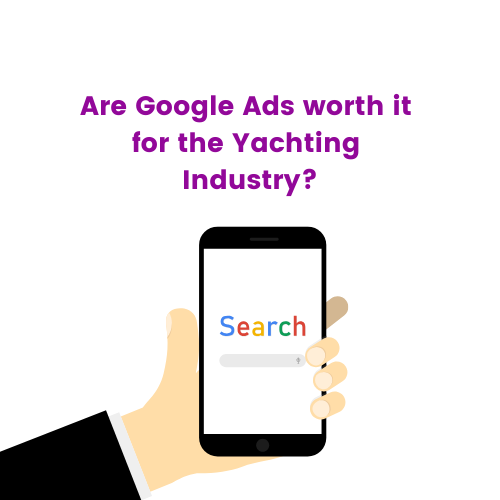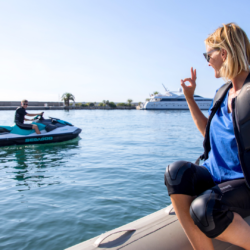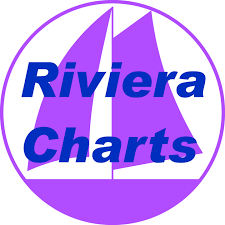By Rebecca Whitlocke
There are plenty of yachting advertising agencies and media buying companies that target the yachting industry, so it’s important to understand if Google Ads are effective and how the right targeting can match your yacht (or products and services) with qualified buyers.
Revenue-driven Google Ad campaigns should have a strategy, but I see so many yachting companies throwing away tens of thousands of euros every month due to poor ad campaigns.
There are plenty of people stating they are an expert at boat advertising, or a marketing specialist for yachting – when they’re not. Two years ago, I was called in to help a superyacht supplier who couldn’t understand why they were spending between €3000 and €5000 per month on Google Ads and only getting a low number of leads. By low number, I mean the results were so bad – about 5 qualified leads – that once I went into the backend of their campaigns I quickly realised that the person they’d employed to run and manage their Google Ad campaigns had no expertise or knowledge how to set up or run an effective campaign. This ‘expert’ had duped them on their CV, and falsely stated they had previous experience managing revenue-driven advertising. The client lost around €15,000 before they called me to clean everything up. Expensive lesson. Within two weeks, I had reduced their Google Ad spend by 84%, whilst increasing their revenue by – yes, those zeros are not an error!
This is why if you choose to include Google Ads in your digital marketing strategy you need to work with a specialist who can demonstrate an in-depth knowledge of audience research, lead generation, targeting, understanding SEO, yachting-specific keyword research, bid strategies, demographics, location-specific yacht marketing and more.
Using Google Ads To Market Your Yachting Company
Yachting companies see that big numbers are “a thing”. But, that “thing” needs context. If you’re getting swept away with big promises of big numbers then you need to know what sits behind it.
Yacht marketing agencies will talk all day about reducing your cost per click, cost per impression, increasing the click-through rate and boosting the lifetime value, but how many opportunities are they actually creating for you, and what does your qualified sales pipeline look like?
What Does A Google Ad Look Like?
Google Ads is a digital advertising service that lets you promote your products or services on various Google platforms, including Google’s search engine, YouTube, and other affiliated websites. For search results for yachting terms, you’ll likely see Google Ads at the top of the search results. A Google Ads result looks like this in the search engine:
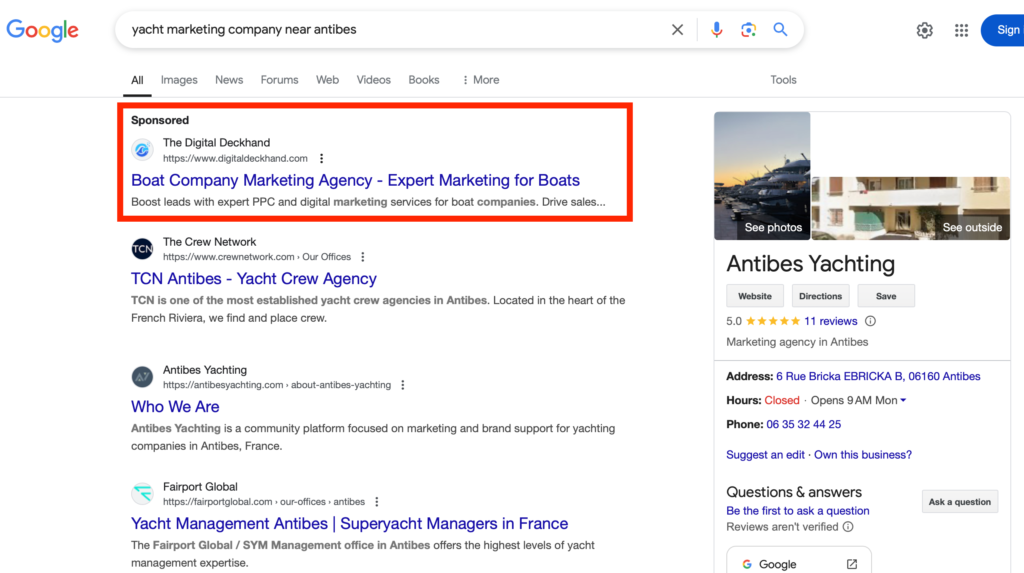
In this example the search results for ‘yacht marketing company near antibes’ shows both sponsored and organic results.
Google Ads are also known as pay-per-click (PPC) or paid search as you pay for them when a user clicks onto them. The intention for Google Ads is that they allow you to attract people who search for phrases or terms related to your company/website.
Google Ads Tips for Yachting Companies
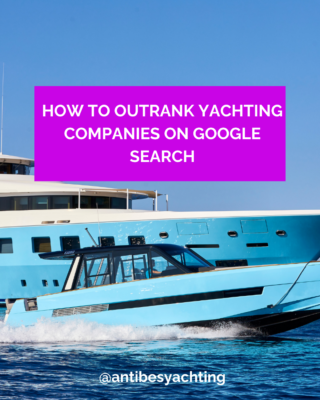
Tips for Google Ad campaigns in yachting
Here are Antibes Yachting’s tips when setting up the right Google Ads campaign for your yachting business.
Identify Your Goals and Choose A Google Ads Campaign Type
Clarify whether your priority is app downloads, brand awareness, direct sales. or lead generation. From that, you can choose the campaign type that aligns with where your target customer spends their time online.
There are five types of Google Ads campaign:
- Google Search ads: Targets users actively searching for products or services via Google’s search engine. They appear on Google’s search engine results pages (SERPs).
- Google Display ads: Reaches users browsing websites related to your products or services. These ads are ideal for enhancing brand awareness and retargeting visitors.
- Google Shopping ads: These show your product listings directly in Google Shopping. These ads are ideal for ecommerce businesses wanting to display their products.
- Google Video ads: Connects with users watching related videos on YouTube. Excellent for visual storytelling. Video ads are ideal for brands looking to engage users with video content.
- Google App ads: Promotes mobile apps across Google’s platforms. App ads are ideal for mobile app developers and businesses with an app-centric customer engagement model.
Focus On Keyword Research
Understanding search intent is important for the success of your Google Ad campaigns. This means you need to use keywords that tap into your target customer’s needs and behaviours.
Semrush gave the perfect example that’s relevant for yachting so I’d reuse that here. Say you run a yacht chandlery that sells life jackets. If you used the keywords ‘life jackets’ or ‘personal flotation devices’ it would work, however, it doesn’t give you any indication of why they’re searching specifically for life jackets.
So, use more specific phrases like ‘life jackets for kids’ or ‘jet ski life jackets’. These search terms reveal much more about the user’s intent. The first suggests parents want safe and comfortable life jackets for their kids. The second indicates a need for life jackets suitable for water sports activities.
If you’re targeting parents, your Google ad could say, “Keep Your Children Safe with Adjustable Life Jackets for Kids.” For the jet ski enthusiasts, you might focus on the lightweight design and utility, like “Lightweight Jet Ski Life Jackets for Your Next Adventure on the Water.”
To help you with keyword research, take a look at Semrush’s
Keyword Magic Tool. This isn’t a sponsored post, however I’ve used this keyword tool regularly and it’s excellent. In the search menu, go to “SEO” then to “Keyword Magic Tool”.
Type in a general search keyword related to your business, choose the location you’re targeting, and hit “Search”. Now, here’s where the magic happens. When the search results display, look at the “Intent” column.The letters in this column represent four different types of search intent:
- Informational (I): “What is the safest life jacket for small children?” The user is looking for information about life jackets.
- Navigational (N): “Yachting Marketplace life jackets.” The user wants life jackets from a specific brand or store, or even a certain page.
- Commercial (C): “Top-rated life jackets for jet skis.” The user wants to research life jackets before making a purchase.
- Transactional (T): “Buy life jackets online.” The user wants to buy life jackets.
Focus strongly on the keywords with commercial and transactional intent for your Google advertising campaigns because they are targeting prospects who are ready to purchase.
📌OTHER KEYWORD TOOLS TO USE:
Google Keyword Planner
Google Analytics
Ubersuggest
Spyfu
Make sure you group your keywords into ad groups and campaigns with similar themes.
Use Negative Keywords In Your Google Ads Set Up
Negative keywords are words or phrases you intentionally exclude from your campaigns to stop your ads showing up in irrelevant searches for your company. As an example for yachting, say you own a luxury yacht interiors company. By adding negative keywords like “cheap,” “used,” or “refurbished” this ensures that your ads won’t appear in searches for cheaper or second-hand options, focusing your ad spend on customers interested in new, premium yacht interior products.
Use tools to do negative keyword research. For instance, if you run a yacht painting company, avoid spending money bidding on keywords for yacht charter, yacht berths or other irrelevant keywords.
One example I saw recently, you can see in my graphic below. Hill Robinson, a well-known yachting company, is running 18 paid ads to come up in Google search in France. This includes some irrelevant keyword and search terms, which aren’t related to their core services of yacht management, charter, crew services.
Not using negative keywords is probably one of the most common Google Ads mistakes I see in the yachting sector, which can be avoided.
Create Audience Segments & Connect Your Google Analytics (GA4) To Google Ads
Setting up audience segments in Google Analytics (GA4) makes it easier to track their online behaviour and target them in your Google ads. For example, you can use Audiences to create segments of users :
- By demographics: age, gender, income etc
- By hobbies & interests: browsing behaviours, hobbies, lifestyle choices etc
- By location: city, region, country
- By past interactions with your business: such as they signed up for your yachting newsletter, they bought something from your e-commerce pages, or they looked online at a specific yachting blog post, product page, or sales page.
You can modify all these conditions with a time span. For instance, you can create an audience specifying who viewed a certain page, such as yacht charter listing in Monaco or a yacht engine part, within the last week. This feature helps ensure your audiences are current—not filled with prospective customers who’ve already moved on.
Audience segmentation is a powerful feature when linked to your Google Ads account, because you can remarket to these people. For the steps to link your Google Analytics account to your Google Ads account, refer to this help guide from Google: https://support.google.com/analytics/answer/9379420?hl=en#zippy=%2Cin-this-article
Write Yachting-Specific Ad Copy
Writing ad copy is more complex than it seems, because the aim is to highlight your yachting products or services and make the customer take action.
If you want to write Google Ad copy that is more likely to attract yachting customers, here are some of my tips:
1. To get inspiration from successful ad copy for your Google Ads campaigns, under “Advertising” > “Keyword Research”, “Ads History” you can enter a keyword, location and click search and it will display top-ranking Google Ads for that keyword in the past year. It will show you: the amount of traffic generated and the spend for buying traffic for that keyword. On the right-hand side, you will see a grid – usually O and 1 numbers – that shows that ad’s positioning that month. Obviously, position 1 is top rank so you can click on those to see the EXACT ad copy that was used. Don’t copy it word-for-word – use it for inspiration to create your own ad copy.
2. Use a strong headline that gets people to react. Avoid clichéd yachting terms such as ‘unrivalled’, ‘unparalleled’ or ‘innovative’. Don’t use fake scarcity such as headlines stating ‘sales are ending soon’ when they’re not.
3. Make sure your ad copy is concise (no waffling text!).
4. Make sure your ad copy is adaptable to different devices and screen dimensions.
5. Highlight the benefit to the customer, not just the product or services features.
6. I highly recommend you use ad extensions such as image extensions, location extensions, price extensions, promotion extensions, structured snippets or sitelink extensions. Extensions do not cost anything to add to your campaign. However, if someone calls you from your call extension or downloads your app from the app extension, you’ll be billed for a click. To find them in your Google Ads account, you simply click on the “Ads and Extensions” tab on the left side of the page, then choose “Extensions”. Click onto the
+ button in the top left corner and select the relevant ad extension option you want from the drop-down menu. To learn more about ad extensions, take a look at this useful article by Neil Patel:
https://neilpatel.com/blog/essential-adwords-extensions/7. Use Semrush’s
Advertising Research tool to see where your competitors are gaining or losing keyword positions, and take a look at their ad copy. Note: You get 10 free requests, or you can subscribe to Semrush.
Use Geo-targeting For Better Google Ad Results
Most yachting companies are familiar with geo-tagging from social media. So, this works in the same way for Google Ads – you can include local keywords (like city names) to attract local customers if your business serves specific geographic areas.
Say you run a yacht charter company in Cannes. Geo-targeting ensures that your Google Ads will show to people looking to rent a yacht in Cannes. This targeting can increase website visits, visits to your physical charter office (if you have one!) and prevent unnecessary budget spending on wasted ads for areas where you don’t operate such as Monaco or San Remo.
To use geo-targeting in your Google Ads campaigns, under “Campaigns” > “Audiences, keywords, and content” in the left-hand navigation bar, click “Locations” then you can edit the locations and set a radius. Tip: Don’t forget to also edit “Location exclusions.”
Think About Creating Relevant Landing Pages For Your Google Ads
Creating a landing page that’s relevant to your Google Ad means that customers feel like it delivers a promise when they click on it – essentially, the landing page should closely match the ad in design and message. Landing pages should have a clear, call-to-action and use imagery that complements the main ad.
Not all Google Ads need landing pages. Landing pages can be effective when you need customers to take a specific action such as downloading a white paper or registering for a webinar.
Use AI and Smart Bidding For Your Google Ad Campaigns
Smart Bidding uses historical data and adjusts your bids based on audience behaviour, device, time of day etc. In your Google Ads account, under “Campaigns” > set it up by clicking on the “Settings cogwheel”, then “Bidding”, when you can change your bid strategy.
Use a combination of broad match, responsive search ads and Smart Bidding to reach more relevant searches for your business.
Use Tools to Help Your Google Ads Performance & Market Research
There are numerous Google-approved tools and SEO tools that can help you run and track your Google Ads performance, as well as find opportunities to grow your business.
I already mentioned keyword tools above under the Keyword Research section of this blog. Another major one you would need to know is Google Analytics (GA4), that replaced Universal Analytics in July 2023. To measure the success of your advertising, Google Analytics will track the performance of every campaign. You can track and monitor conversion rates, click-through rates, cost-per-click and the ROI. This will help you identify behaviour and trends, so you can adjust your budget and strategy.
📌OTHER TOOLS & SITES TO HELP YOUR GOOGLE ADS PERFORMANCE & MARKET RESEARCH:
Google Cloud Natural Language to test copy (paid tool): https://cloud.google.com/natural-language
Google Search Console
Finding A Google Ads Expert For Yachting
Can you set up and manage your own Google Ads? Yes, absolutely. However, make sure you or your dedicated marketing employee has the technical skills and knowledge to develop campaigns that reach your business goals. That means monitoring competitor activity and market trends, setting up segmentation and ad groups and controlling the days and times when your ads show up.
Here’s the ‘million dollar question’: How much does a Google Ads expert cost? If you want to outsource to a Google Ads specialist or a yacht advertising agency, the amount of time your campaign requires and how much you pay will depend on factors like the duration and size of your campaigns and the complexity of the work to be done.
Many yacht marketing agencies charge a flat monthly fee for managing your Google Ads campaign. For ongoing monthly management, these fees typically range from €75 per hour upwards. There can also be one-off fees to set up your Google Ads account (around €500 upwards), or keyword research (€1,000 upwards). Ad agencies typically charge a percentage of the ad spend, which can range from 15% upwards. For example, if a yacht charter business spends €10,000 on ads, the yacht advertising agency may charge a marketing fee of €1,500 for their services.
Yacht Marketing for Small Businesses
In this next section, I will explain whether it’s possible for smaller yachting companies to compete with larger yachting companies online. The reason I want to break it down here is because many business owners I know do not have a budget of tens of thousands of euros to spend every month on paid advertising – that may be a hard truth as no one wants to admit it, but that is the reality for most startups and small businesses.
So, the key consideration is: How do small businesses in yachting maximise their resources to get attention from prospective customers?
Here’s one example of paid advertising in my video below: Versilia Provisions, a local yacht provisioning company, is bidding on keywords associated with yacht marketing, which is irrelevant to their main services which are yacht provisioning and interior supplies. This means their Google Ad costs will be higher because they haven’t added negative keywords. I don’t supply yacht provisioning, so they shouldn’t be coming up in searches for the same customer base as me (Antibes Yachting).
Through all of my client marketing, I always highly recommend yachting businesses focus first on assets they already own and can control the output – such as their website blog section, or company newsletter. This is by far the easiest way to control your messaging, and it is an asset because it stays permanently published on your own site or reaches your database directly when you send out a newsletter.
We have seen numerous third-party platforms or channels fold or go offline, and as we saw when TikTok collapsed, if yachting companies are putting all their marketing eggs into one basket then you are at risk of your company’s visibility evaporating overnight.
Here’s my tips for yacht marketing for small businesses:
1. Stick to a budget. Yachting companies get sucked into this alternative vortex where they think they must set up 20 different ad variations for various keywords, with a €10 daily budget. Before they know it they’ve wasted €6,000. Test, test, test ad variations with a small budget first and track results. You can always increase your budget later.
2. Write your copy as you speak. Don’t overcomplicate your advertising, marketing or website copy with jargon or technical terms. With artificial intelligence playing more of a role in content creation, there’s even more clichéd copy in the industry than before. You will not stand out in a competitive industry copying what others do!
3. Mix up the format and type of content you create for each platform. Use blog posts, bullet points, images, infographics, podcasts, videos and webinars to keep content interesting and help your audience understand what you’re saying. It’s perfectly fine to repurpose content that performed well.
4. Prioritise creating and publishing E-E-A-T content: Expertise, Experience, Authority, and Trustworthiness – these should be a big focus of your content strategy.
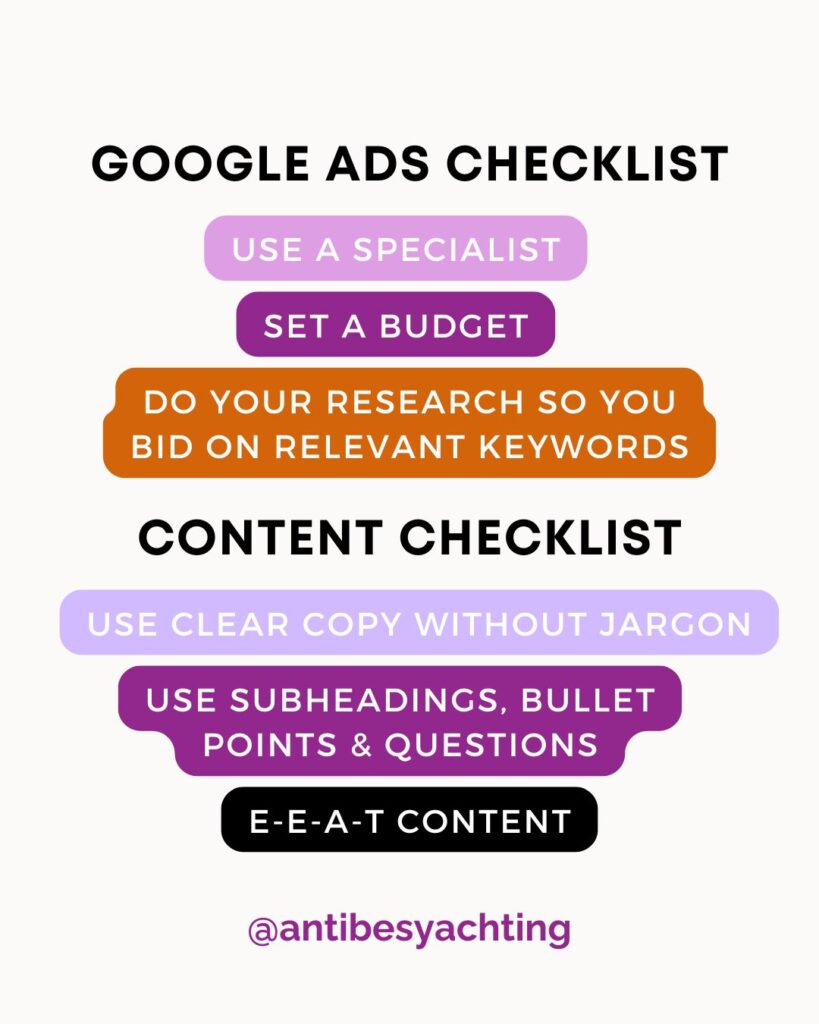
Google Ads & Content Checklist for yachting companies
Summary
According to Neil Patel, “The average Google Ad converts just 4.40 percent of the time.” Whether your company feels that is a good return on investment is up to you.
Do I think Google Ads are important for yachting companies? They have pros and cons, like all marketing tools or tactics. It’s possible to get great return on investment with a relatively small budget. However, I truly believe – and have seen the results – that yachting companies aren’t knowledgeable enough to maximise Google Ads, and many yacht advertising agencies are not skilled enough to deliver what they say they will.
At the end of the day, creating informative relevant content such as lengthy comprehensive information, including sources from niche-specific websites, is going to help your yachting company in the long run, whether you boost that by paid advertising or not.



